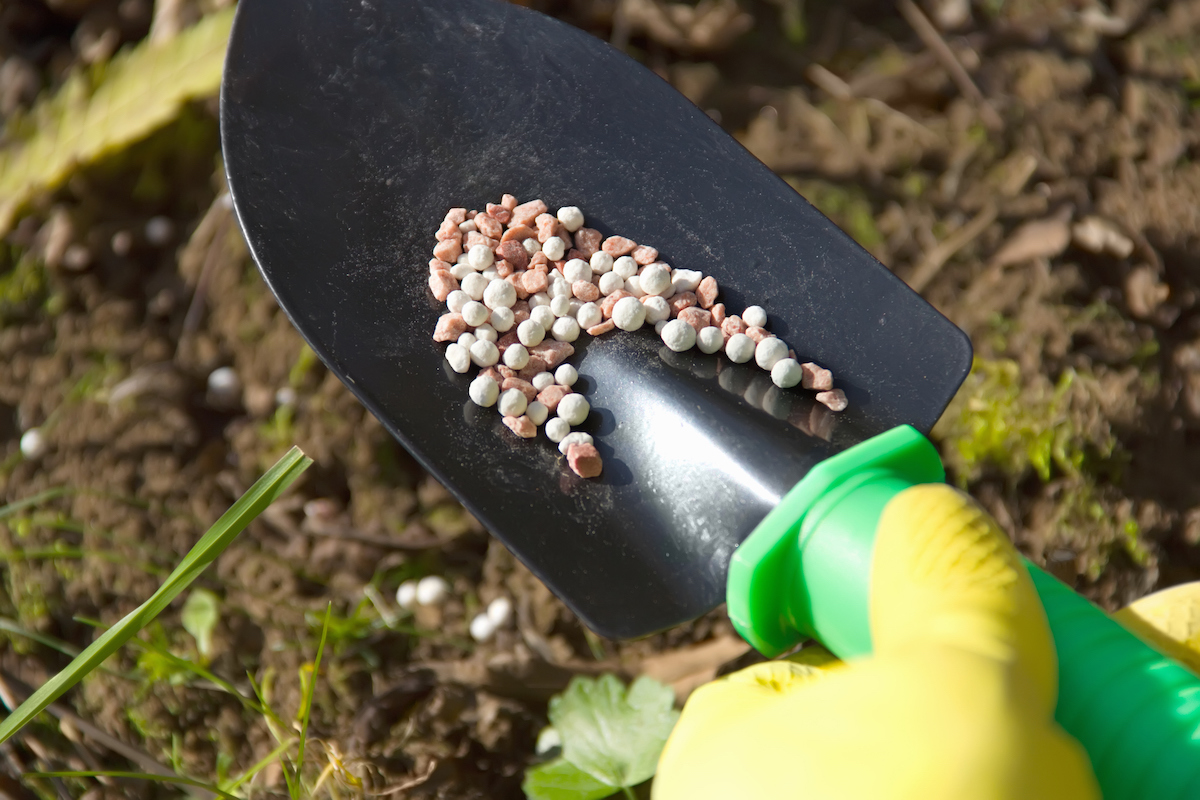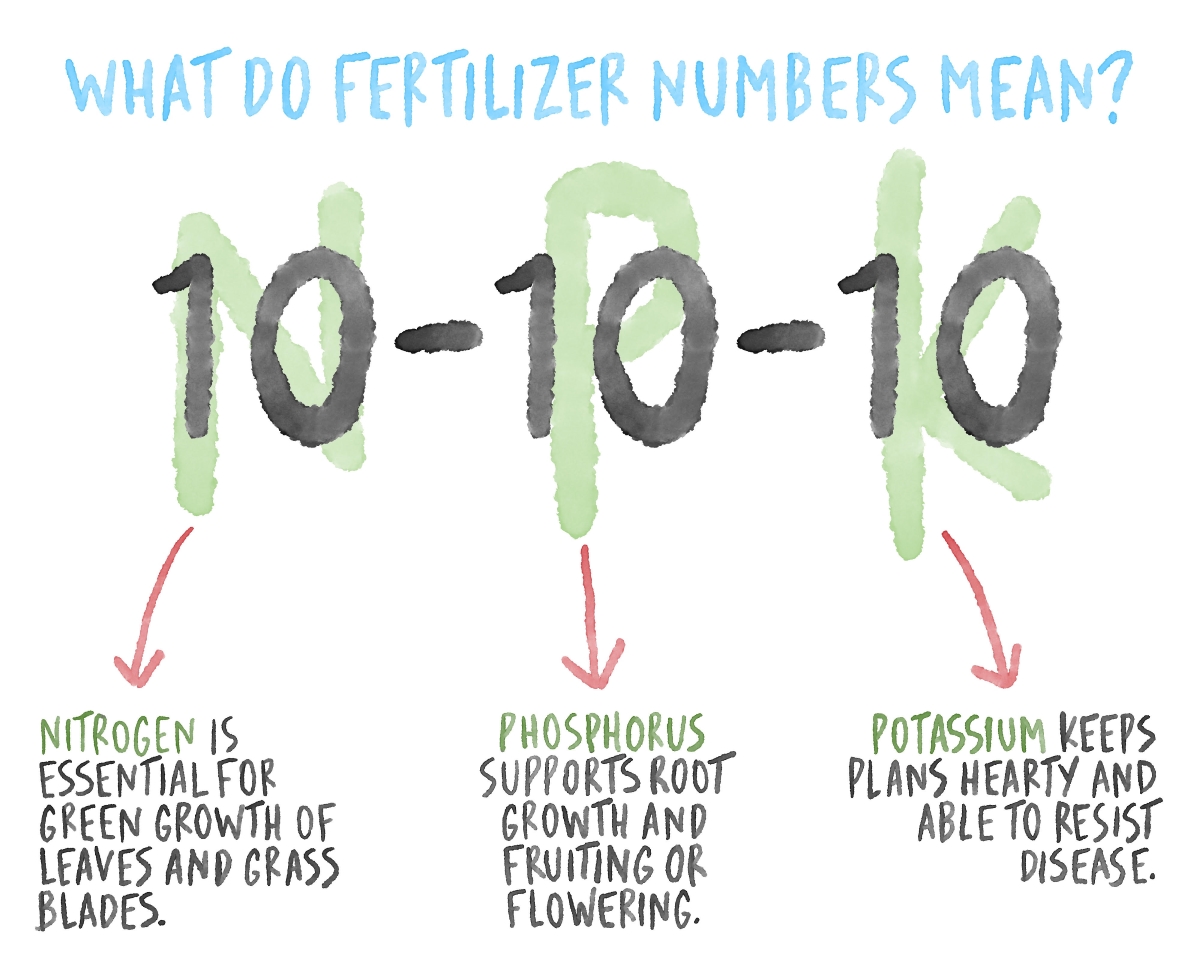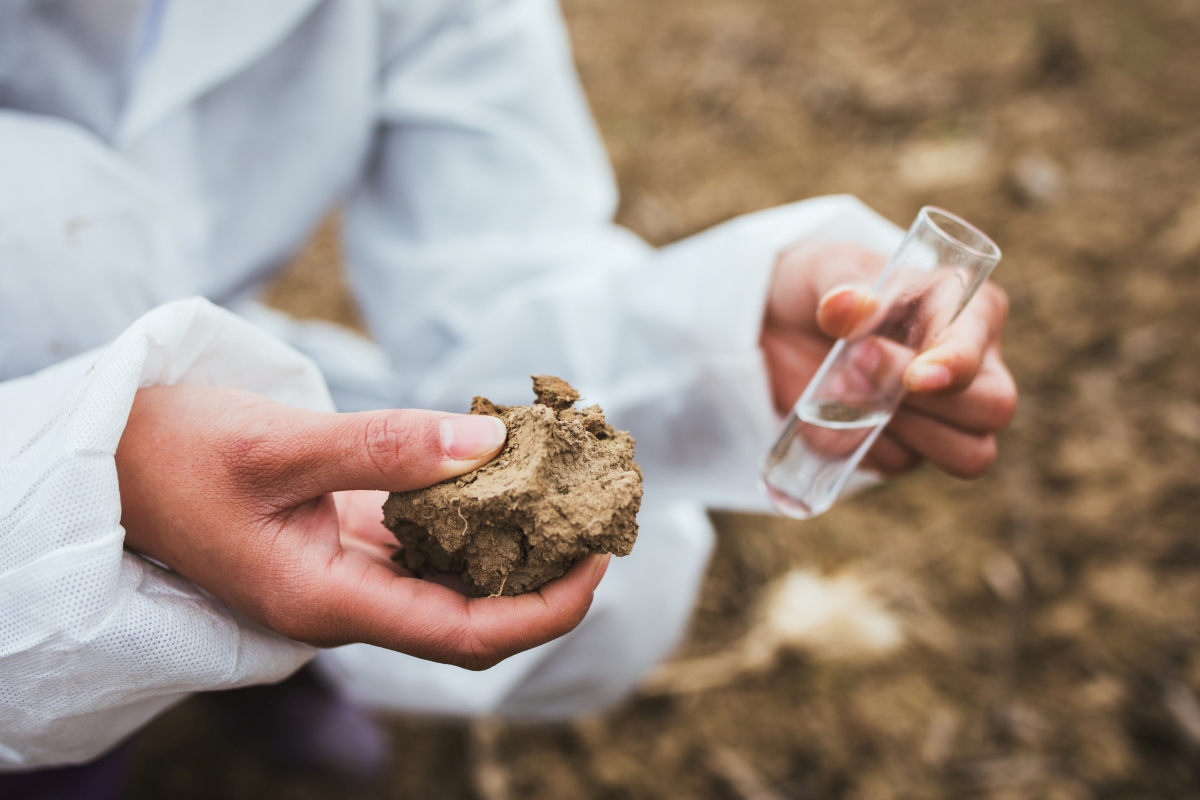

We may earn revenue from the products available on this page and participate in affiliate programs. Learn More ›
View the numbers on fertilizer packaging as similar to the nutrition information labels on the foods we eat: Separated by hyphens, the three numbers on fertilizer are required by state fertilizer labeling laws to show consumers the products’ nutrient value for plants.
These fertilizer numbers, which you’ll see written as 6-4-3, for example, are a fertilizer’s NPK numbers. Although scientists have identified 17 essential plant nutrients, the three most important are nitrogen (N), phosphorus (P), and potassium (K), the NPK fertilizer numbers display prominently, often in large numbers on the front of the label.
Gardeners who understand these numbers and the nutrients they represent are best equipped to select fertilizers that are appropriate for their plants’ needs, such as liquid lawn fertilizers. Here’s what you need to know about the roles that nitrogen, phosphorus, and potassium play in plant growth, and how to choose the right balance of these nutrients for your garden plants.
What do NPK fertilizer numbers mean?
The explanation is simpler than it might seem: NPK fertilizer numbers always appear in the same order. Nitrogen (N) feeds leafy plant growth. Established lawns use nitrogen grass fertilizer to grow, and stay green, throughout the year. It’s usually wise, then, to select a high-nitrogen fertilizer for grass, especially as the fertilizer for new grass. Trees and shrubs need less nitrogen because they produce only one set of leaves per season.
Phosphorus (P) stimulates root, flower, and fruit development, helping plants convert sun’s energy to benefit the plant. Annual flower beds, fruiting plants such as tomatoes, and newly planted seedlings sometimes need a boost of phosphorus. However, if the soil already contains a sufficient amount of this element, adding more will cause more harm than good.
Potassium (K) is essential to virtually all plant metabolic processes, helping the plant move and use nutrients available to it. Potassium promotes strong stems, well-formed flowers, robust fruits, and healthy roots, and helps plants use water and resist drought. Most soils provide some natural potassium, but it might not be enough for certain plants.
N-P-K numbers represent the percentage of each element in the fertilizer.

The three numbers on fertilizer bag labels represent the percentage of each element, by weight, inside the package. For example, a package of 24-0-6 fertilizer contains 24 percent nitrogen, 0 percent phosphorus, and 6 percent potassium. The balance of the package’s contents is made up of other nutrients (which will be listed somewhere on the label), and/or inert ingredients.
Comparing the percentages helps consumers know whether a product is high in the element their soil lacks, or a particular plant needs. It also can prevent adding too much of a macronutrient. If plant care calls for a balanced fertilizer, even NPK numbers like 5-5-5 or 10-10-10 indicate general all-around macronutrients inside.
Once you know the percentages of each element in a bag of fertilizer, you also can determine the weight of each element. This calculation comes in handy if you’ve had your soil tested and have been directed to amend it with a specific amount of a particular element. Buying too much could cost you more money for fertilizer than could eventually go bad.
As an example, an 18-pound bag of 24-0-6 contains 24 percent nitrogen, which amounts to about 4.32 pounds of the element (18 x 0.24 = 4.32). If the local extension office tests your soil and suggests that you apply 1 pound of nitrogen per 1,000 square feet of lawn, the 18-pound bag would cover 4,320 square feet (1,000 x 4.32 = 4,320) at the recommended rate.
Synthetic fertilizer numbers are usually higher than those of organic fertilizers.
The NPK number is an excellent way to compare elemental nutrient values of different types of fertilizer. The numbers show how much elemental nitrogen, phosphorus, and potassium there are in the mix; it does not matter whether it is quick release, slow release, or organic. If the sources of each nutrient concern you, it’s a good idea to check the fertilizer’s ingredient list.
Inorganic, or synthetic, fertilizers typically have more concentrated NPK loads—in other words, higher NPK numbers—than organic fertilizers. Gardeners can apply less synthetic than organic fertilizer to deliver an equal amount of nutrients. For this reason, synthetic fertilizers are more cost-effective.
Organic fertilizers are derived from natural ingredients that are minimally processed. They take longer to break down and provide your plants with a slow, steady feed of nutrients, sometimes over the course of many months. In the case of accidental spill or overapplication, these fertilizers are less likely to damage plants or soil.
Plants need more than the “big three” elements to thrive.
As we mentioned earlier, there are 17 nutrients that are essential to plant growth. Nitrogen, phosphorus, and potassium are macronutrients that are contained in most fertilizers. Plants get carbon, hydrogen, and oxygen, through air and water. Calcium, magnesium, and sulfur are considered secondary nutrients, which means that they are important to plants, but plants need less of them than they do of the big three (N, P, and K).
The remaining 10 essential plant nutrients—boron, calcium, chlorine, copper, iron, magnesium, manganese, molybdenum, sulfur, and zinc—are micronutrients, or trace elements. While trace elements are essential to plant health, they are needed in much lower quantities than the rest. Fertilizers may include some or all of the trace elements, but your garden may or may not need more of them.
When following credible recommendations for NPK ratios for various plant needs or problems, it is less important to match precisely than to find a similar ratio to that recommended. And generally, matching nitrogen is most important, without exceeding recommended phosphorus. The best way to find out which elements your soil needs is by conducting a soil test.
Testing your soil will help you select the right fertilizer.

Soil testing is the surest way to know which nutrients are lacking, which are plentiful in your garden soil, and what NPK fertilizer ratio might help. The results of the test include both an analysis of your soil as it is, and recommendations for fertilizer applications and rates to safely correct deficiencies. While home soil test test kits are available, the most complete and reliable results come from lab tests.
Every state in the U.S. has a Cooperative Extension Service associated with its university system. Contact your county Extension Agent’s office for directions on how to collect and submit soil samples. The average cost is $11 to $30 per soil test, and it takes about a month to receive the results.
FAQs
Most fertilizers for lawns and garden plants work best if you water after applying them. The reason is that the fertilizer needs to work down toward the turf’s or plant’s roots, and water helps accomplish that. This is especially true of granular, or solid, fertilizers. With liquid fertilizers, some of the nutrients reach the roots through the grass blades, so watering is not as critical right away. However, always try to water within no more than 24 hours of applying any fertilizer, sooner if possible. Or, apply granular fertilizers during or just before rain.
Typically, the best time to fertilize the lawn is in early spring and a few times during the season (waiting at least 6 weeks between applications). Timing might vary for winter lawns (cool-season grasses), so be sure to check instructions for specific grass types or climates.
As for the best time of day to fertilize grass, any point of the say can work. However, morning or late evening are usually better for summer applications. Avoid applying fertilizer during extreme heat. If your sprinklers are set to run in the morning, it is a good idea to apply fertilizer right before their usual run time.
To ensure grass is not grown too much for seeds to make their way in and take hold, it’s best to avoid fertilizing a few weeks before overseeding. Once you overseed, however, you can apply a slow-release fertilizer right away to provide a gradual supply of nutrients to help new grass grow and existing grass to remain healthy. Just be sure to water well and avoid overfertilizing or applying fertilizer again until about 6 weeks.
